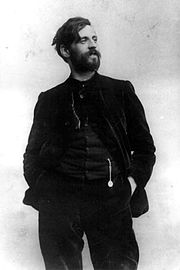Galileo Chini
Italian painter (1873–1956) From Wikipedia, the free encyclopedia
Galileo Chini (2 December 1873 - 23 August 1956) was an Italian decorator, designer, painter, and potter.[1]
You can help expand this article with text translated from the corresponding article in Italian. (May 2015) Click [show] for important translation instructions.
|

Biography
A prominent member of the Italian Liberty style movement, or Italian Art Nouveau, he taught decorative arts at the Accademia di Belle Arti in Florence. He was responsible for several of the paintings and decorations in the Brandini Chapel at Castelfiorentino, the church of San Francesco de' Ferri in Pisa, and the Ananta Samakhom Throne Hall in Bangkok. He helped design and decorate rooms in the Palazzo dei Congressi, Salsomaggiore Terme. His theatrical work included designing the sets for the European premiere of Puccini's opera Gianni Schicchi (Rome, January 1919) and the world premiere of his Turandot (Milan, 1926). He also created the sets for the premieres of Umberto Giordano's opera La cena delle beffe (Milan, 1924) and Sem Benelli's play of the same name on which the opera was based (Rome, 1909).
Influenced by Gustav Klimt, Chini and Vittorio Zecchin (1878 – 1947) created a number of panels in 1914 for the Venice Hotel Terminus called "La Primavera" and "Mille e una notte".[2][3][4] These were later exhibited in the Boncompagni Ludovisi Decorative Art Museum.[5]
Gallery
- Portrait of Galileo Chini
- Ceramic tile façade decoration (1904)
Sources
- Capri, Antonio (1971). Storia della musica: Dalle antiche civiltà orientali alla musica elettronica , Casa Editrice Dr. Francesco Vallardi.
- Pedagotti, Simona (2005). "Galileo Chini and the Brandini Chapel" in Francesca Allegri and Massimo Tosi (eds.), Castelfiorentino: Terra d'arte: centro viario e spirituale sulla Francigena, pp. 185–189. Federighi. ISBN 88-89159-07-3
- Peleggi, Maurizio (2002). Lords of Things: The Fashioning of the Siamese Monarchy's Modern Image. University of Hawaii Press. ISBN 0-8248-2558-6
References
Wikiwand - on
Seamless Wikipedia browsing. On steroids.


